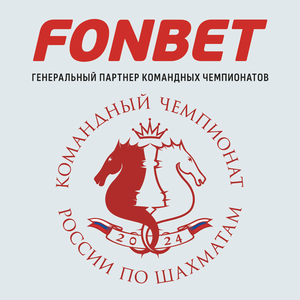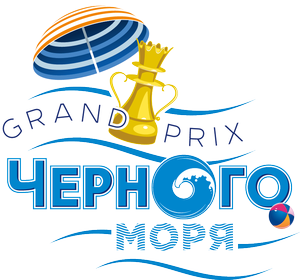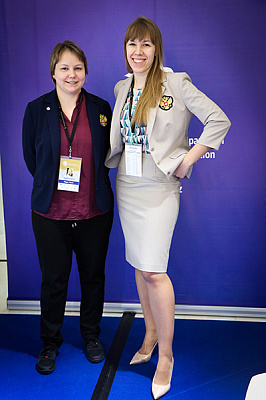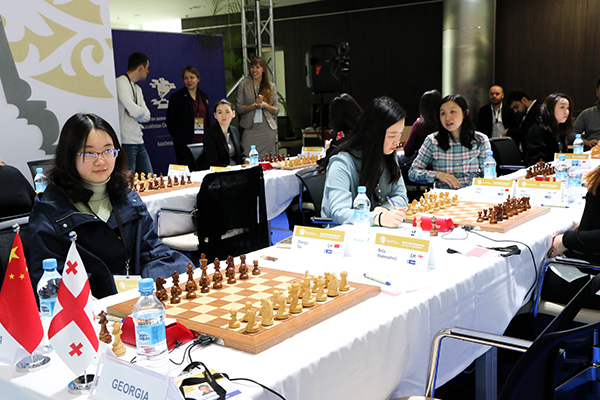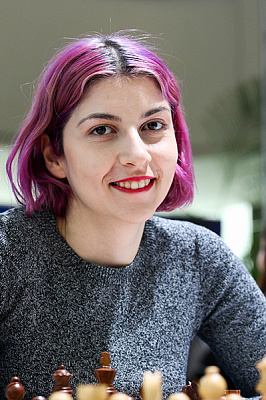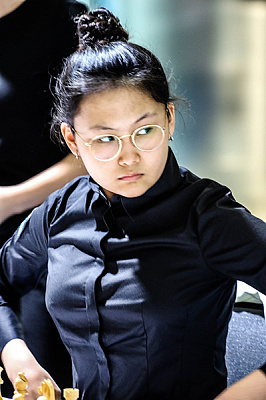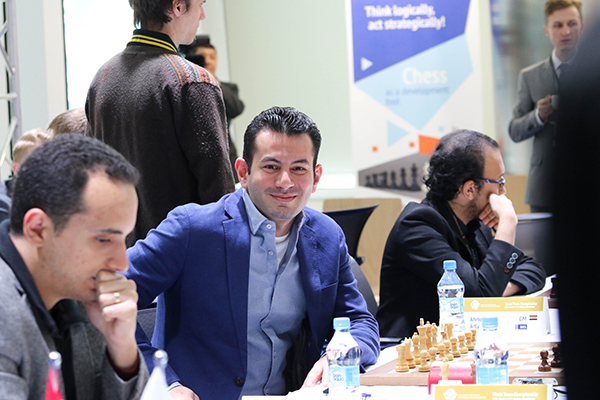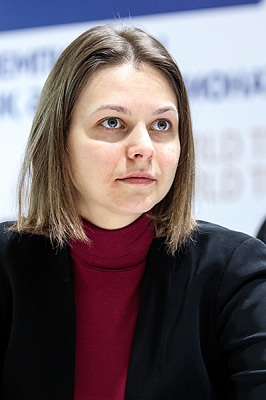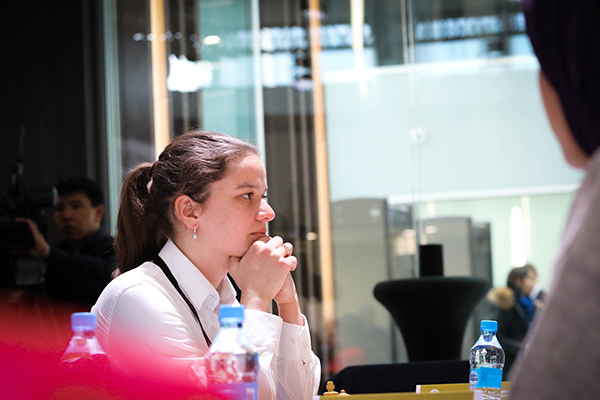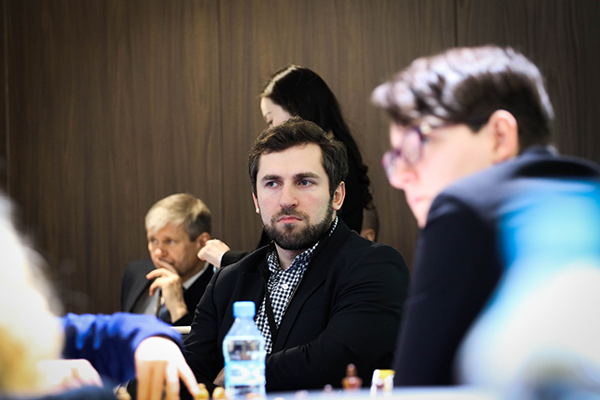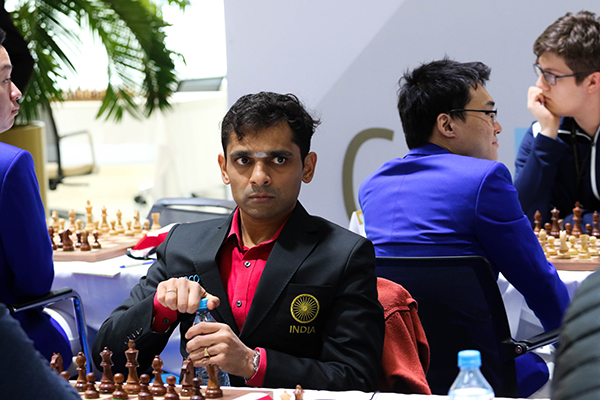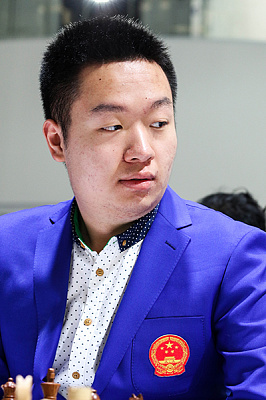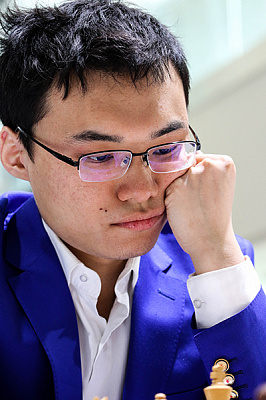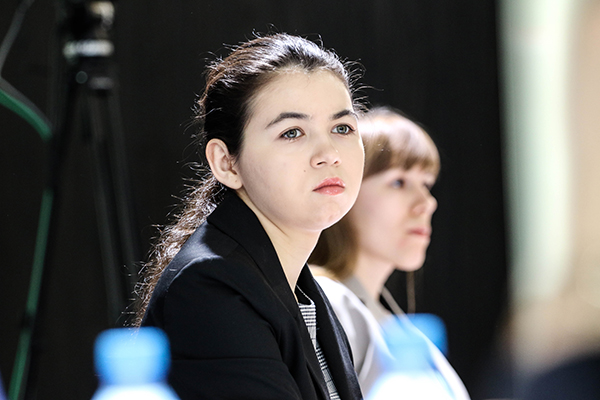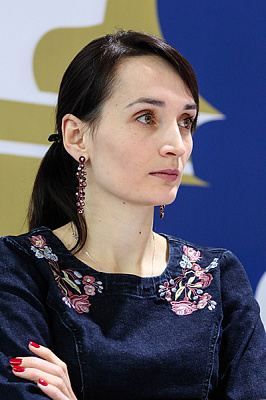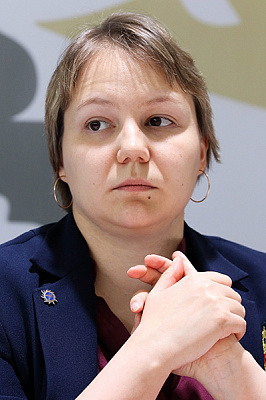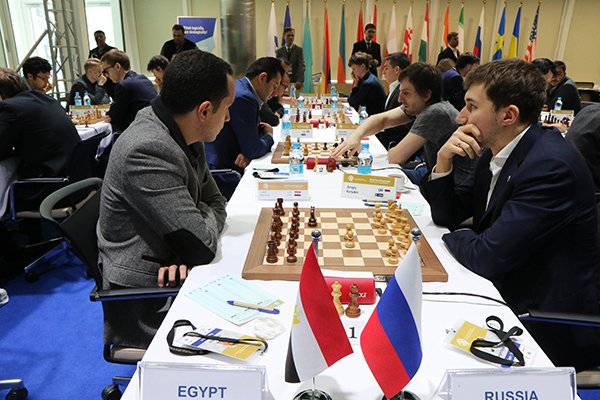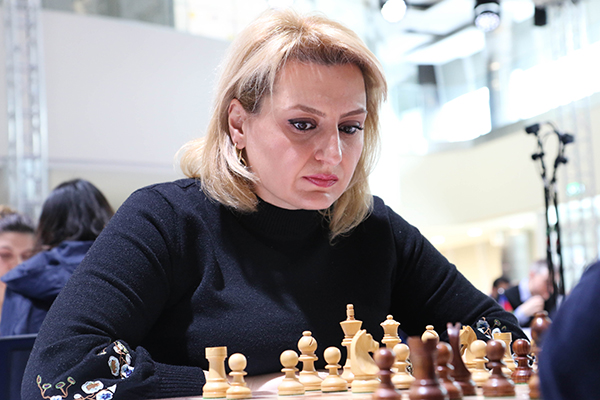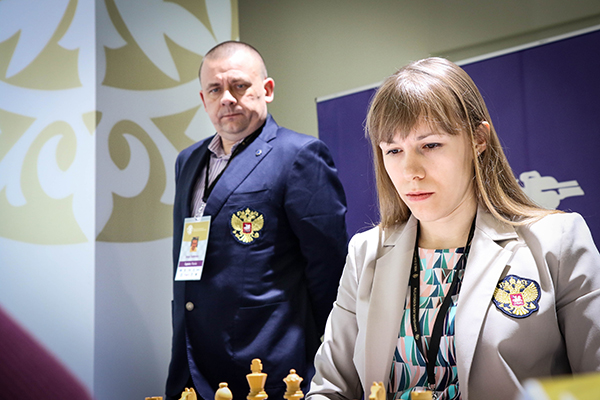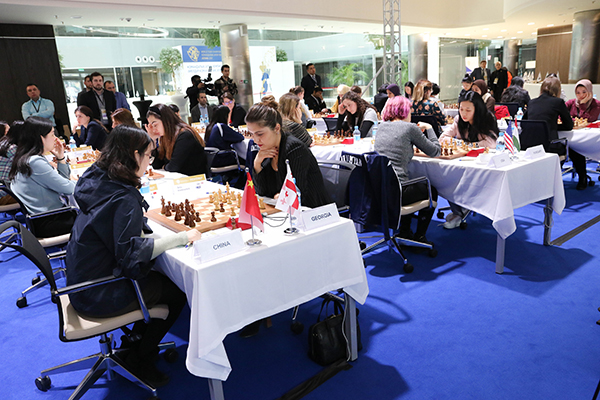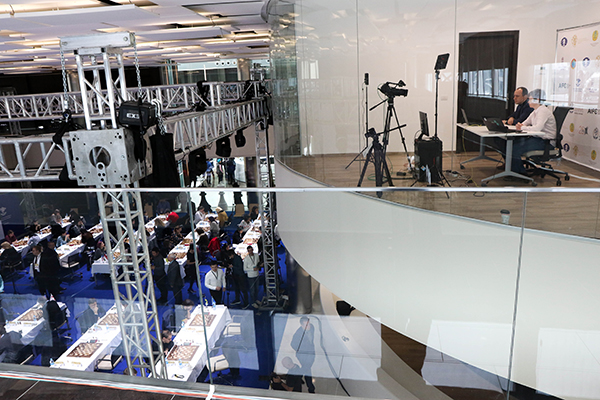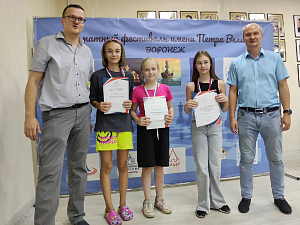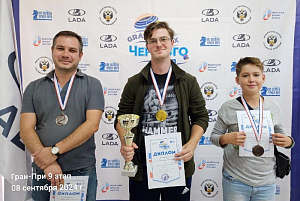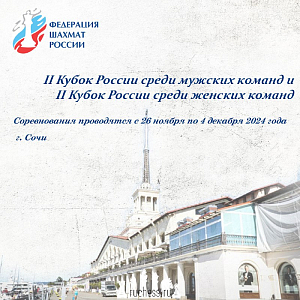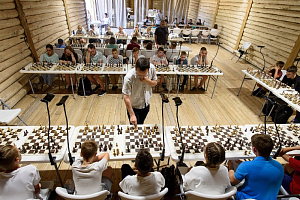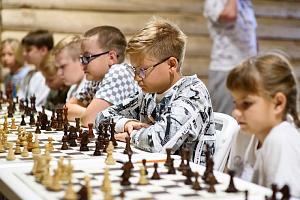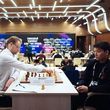Taking Your Coach by Surprise
Eteri Kublashvili reports on Round 2 of the World Team Championships
Round two had our team pitted against Egypt - an underdog team that is often quite a challenge for us nonetheless. This time the outcome is 3:1 in favor of the Russians.
On board one Sergey Karjakin faced Bassem Amin in a game that he characterized as a crazy one. He eventually succeeded and this is what he has to share with us:
– The thing is, I have never as much as mentioned this line to my coaches because I did not feel like scaring them (laughing). I have opted for the most complex of lines. Even the KID gives you a choice of more tranquil continuations, but I think my approach was a principled one.
Karjakin – Amin

The opponent surprised me with 15…Rf7, because the mainline is 15…Nf6 16.c5 with the craziest of lines arising afterwards. Having gone to considerable lengths to have them analyzed with my seconds, I was well prepared for the game; however, the position is so double-edged that it defies even the engines. Black would sacrifice material from time to time (as was the case in today’s encounter), misleading the engines to give White a substantial edge, whereas Black's offensive potential is quite a danger.
16. Bf2 Bf8
I think he needed to go for 16…Nf6 because the text gives me an edge after 17. Nb5.
17…a6 18. Na7 Rxa7!
Should Black refrain from sacrificing the exchange, White grabs the c8-bishop, known to be vital for Black’s mating attacks and sacrifices on h3. White would have a strategical superiority in this case. I anticipated Black's coming up with the exchange sacrifice and thought that 19. Bxa7 Nf6 gives me an option of evacuating my king from the kingside via f2 and e1, but then I thought against it as not energetic enough. Black will follow by advancing his pawns on the kingside and retaining long-term initiative by undermining my pawn chain.
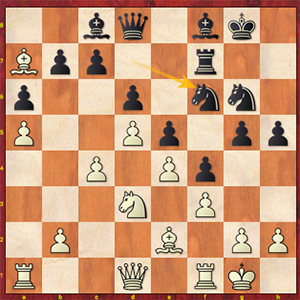
20. с5 is stronger anyway. It is of importance that after 20…g4 21. cxd6 Bxd6 22. Nc5 my knight plants itself on e6, whereas White is still devoid of any checkmating ideas related to bishop sacs on h3 -- he is just never in time to pull it off.
As opposed to it, my opponent decided to put the game on a strategical footing via 22…b5, which is an improvement of his pawn structure at that. I failed to estimate his tricky idea properly.
The setup arising after 23. Ne6 Bxe6 24. dxe6 Rg7 is a key one, I believe.

Here 25. fxg4 seemed consistent with opening up the scope for the bishops. On the other hand, objectively stronger was something positional like 25. Rc1. However, I was worried about his prospects of getting a long-term compensation after g3, h3, Nf8 and subsequent taking on e6. Converting that position seemed like a hard nut to crack, and I decided to take the g4-pawn instead.
25…hxg4 26. Bxg4 Qa8 27. Bf2 Qxe4 28. Re1– a reasonable move.
28…Qb4.
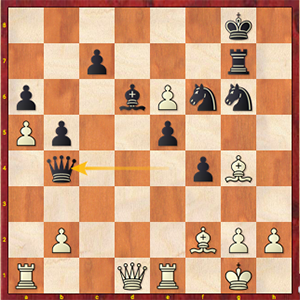
Here I opted for 29. Bf5, which was my initial plan, but this move runs into Black’s 29…e4! I underestimated the consequences of this principled move, such as 30. Qd4 e3 31. Bxe3 fxe3, and bad is 32. Qxf6 in view of 32…Qf4! I ran through various possible continuations, 30.е7 one of them, but there was no judging it one way or another. 29…е4 might have been a way to cast a long shadow over my 25. fxg4. Anyway, 29…е4 creeped up rather accidentally because I had methodically outplayed the opponent and gained an edge, while he didn’t seem to believe that it could really work out well for him in this line.
Meanwhile, after 29…Ne7?! 30. Qd3 the position may be evaluated as winning for White.
***
Winning yet another game is Vladislav Artemiev, who this time was a second player against Abdelrahman Hesham. The game was opened to the Grünfeld Defense 4. g3. While White was busy winning a pawn in the middlegame, Black used this opportunity to seize the initiative and create a dangerous a-passer.
Hesham – Artemiev
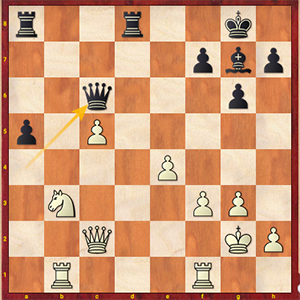
Vladislav classified 26. Nc1?! as a decisive mistake. Stronger was 26. Rfd1, and now 26...a4 is unpleasantly met by 27. Na5!
Meanwhile, the text allowed the passer a free ride to as far as it would go. 26…a4 27. Na2 a3 28. Nb4 Qa4 29. Qa2 Rab830. Nd5 Rb2+ 31. Rxb2 axb2.
Despite the lack of a pawn, Black got a winning endgame thanks to the far-advanced passer. After the trade of queens Vladislav was adamant in bringing his edge home.
Ahmed Adly was not overly ambitious against Alexander Grischuk by agreeing to repeating moves in the Grünfeld Defense. As it made no sense for Grischuk to persist looking for ways to keep up the game, a draw was agreed after the Russian player made his eleventh move. People well-versed in chess history did not fail to inform that it was not the first time in Alexander Grischuk’s praxis as he had agreed a draw on move 11 with Salem Saleh two years ago at the Moscow leg of Grand Prix.
Dmitry Andreikin and Adham Fawzy opened the game into the Catalan, in which White got a very promising position out of the opening and embarked on a kingside offensive. However, Black’s tenacious defense denied Andreikin any winning opportunities. Simplifications lead to a balanced position in a major-and-minor pieces ending, in which the opponents decided against persisting further. A draw was agreed on move 34.
China’s going down to team USA, which Sergey Shipov has characterized as having a reserve lineup, has turned into a major upset of the day. On the first two boards the rating favorites Ding Liren and Yu Yangyi displayed stubbornness and resourceful defensive skills to secure draws against Dariusz Swiercz and Samuel Sevian respectively. On board three Wei Yi has granted amnesty to Alexander Onischuk in a winning endgame, and board four Ni Hua went down to Aleksandr Lenderman after blundering a piece in the middlegame.
India – Iran ended in a draw after Maghsoodloo’s defeat from Adhiban was atoned for by Sasikiran’s going down to Idani.
A second team defeat in a row is suffered by team Azerbaijan, this time from team England. Despite success on board one (Arkadij Naiditsch has defeated Michael Adams), the Azeri team went down on boards two and four.
Sweden – Kazakhstan ended 3:1 in host team's favor, in which a checkmate in the board center was produced as follows:
Ismagambetov – Tikkanen
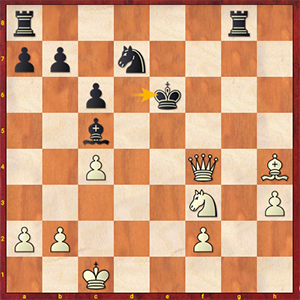
32. b4 Bxb4? 33. Nd4#.
Tournament standings after round 2:
1-3. USA, Russia, England - 4; 4. India - 3; 5-6. China, Kazakhstan - 2; 7. Iran - 1; 8-10. Egypt, Azerbaijan, Sweden - 0.
Coming up in round three is a crucial matchup China – Russia. Other pairings are Iran - Sweden, Egypt - India, England - USA, and Kazakhstan - Azerbaijan.
In the women's championship Russia defeated Armenia 3.5:0.5, thus taking a revenge for the 2018 Olympiad.
The match developments are shared by Sergei Rublevsky, chief coach and team captain present at the theater of actions on a permanent basis:
– Kateryna Lagno, playing Black with Elina Danielian, got a slight edge out of the opening. She retained a slight endgame edge after the trades, and the pawn break on the kingside gave me an impression of White having quite an unpleasant position already.
Danielian – Lagno
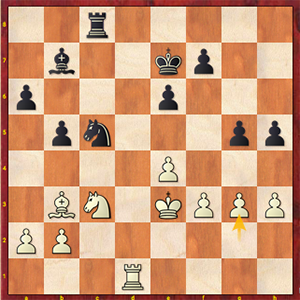
26…g4!
Kateryna went on to confidently bring a point home.
Aleksandra Goryachkina has given a second splendid Black display in a row by not allowing her opponents out of the opening!
Sargsyan – Goryachkina
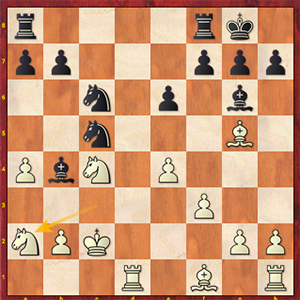
15…f5! 16. Nxb4 Nxb4+ 17. Kb1 fxe4 18. Ne5 Rf5!
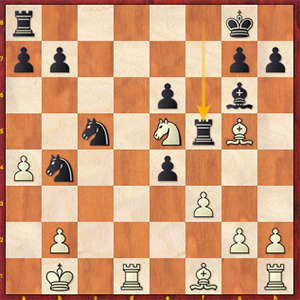
This move is very important. 19. f4 is nicely met by 19…Rxe5 20. exe5 e3+, which forces White to give up material to avoid the knight checkmate on b3.
Meanwhile, after 19. Nxg6 Rxg5 20. Nf4 Rf5 21. g3 exf3 Black won a pawn and converted confidently - Eteri Kublashvili
Olga Girya got a substantial opening edge against Siranush Ghukasyan, winning a pawn in the middlegame. However, converting the endgame edge was not as simple as that and started taking longer than expected. It felt like Black got decent chances for a draw. Nevertheless, Girya’s opponent erred on move 45 by weakening her king and allowing White to capitalize on it.
Valentina Gunina and Lilit Mkrtchian had a very tense game going as White sacrificed a pawn and launched an offensive, which, most likely, was not an entirely correct approach. Black could have probably got a decisive edge in time-trouble, whereas the end of time control marked the position very close to a draw, which the opponents seem to have arrived at after a series of mutual mistakes. The game ended in a draw.
***
A narrow victory in a key matchup was scored by China over Georgia, in which the ex-world champion Tan Zhongyi defeated Bela Khotenashvili in a roughly equal position to bring an overall victory to her team
Team Ukraine whitewashed team Egypt. USA defeated Hungary 3:1, and Kazakhstan vs India ended in a draw.
Tournament standings after round 2:
1-2. Russia, China - 4; 3-4. Ukraine, USA - 3; 5-6. Armenia, India - 2; 7-8. Georgia, Kazakhstan - 1; 9-10. Hungary, Egypt - 0.
Pairings of round three:
Russia - Egypt, India - Armenia, China - Kazakhstan, USA - Georgia, Ukraine - Hungary.








